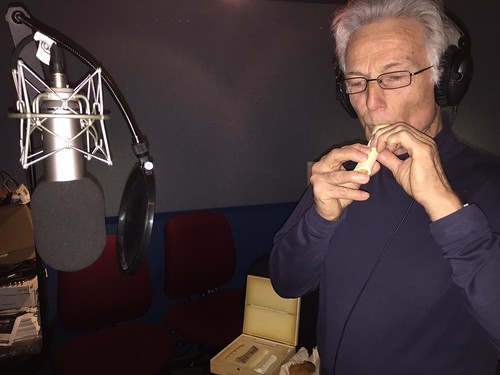Crime Scene Neanderthal (CSN), launching in beta to the public within our Hall of Human Origins this April, will feature (amongst other things) a virtual Neanderthal flute that visitors can play. Maybe you’ve seen this type of thing before on your mobile phone: you see a picture of a flute and then, by blowing into the phone’s microphone and strategically placing your fingers on the photo, you can actually play the virtual flute.
There is only one flute that has ever been identified as POSSIBLY being of Neanderthal origin. Known as the Divje Babe Flute, it is a cave bear femur pierced by spaced holes that was found in 1995 at the Divje Babe archeological park located near Cerkno in northwestern Slovenia (and currently resides in the National Museum of Slovenia).
The CSN flute, however, will offer visitors more than just a cute interactive of the replica on display in our Halls; the experience is designed to walk visitors through the same evidence-based decision making process scientists use to interpret this remarkable fossil find.
It was easy for us to imagine how we might acquire the photos we needed. But where is one to find audio of a Neanderthal flute? That’s where Jelle Atema came into the picture.

Jelle Atema is a Professor of Biology and Adjunct Scientist at the Woods Hole Oceanographic Institution. He is also an accomplished flautist with a particular interest in making Neanderthal flute replicas. Jelle was generous enough to visit the museum this week and demonstrate how this flute might have been played.
Jelle went to both our sound and photography studios to provide us with all the assets required for us to produce the virtual Neanderthal flute. Below are a few videos we made to communicate with our development partners, Geomedia, about how the sound and photos fit together. With Jelle’s permission, I am excited to share them with you below.
(While Jelle is an accomplished flautist, I should note we asked him to demonstrate the flutes in the driest possible way, so we could focus on the different ways the original fossil can be reconstructed and how the fingerings produce different pitches. He quite deliberately avoided making music which would have imposed his personal taste on a Neanderthal flute.)

In the first video, Jelle plays the quena-style flute (3 holes), as developed by the Slovenian museum and as seen at AMNH:
In the second video, Jelle plays the fipple-style flute (4 holes), developed by himself using a modern black bear bone provided by a museum:
In the third video, Jelle plays the fipple-style flute (4 holes), developed by himself using a 50-100,000 year old European cave bear fossil provided by a European museum (not that Neanderthals would have used fossils, but still…):
Finally, Jelle plays a lobster. (Did I mention Jelle’s research focuses on lobster’s fine sense of smell and what they teach us about chemical communication under water?). Why do we want Jelle to play a lobster from his research collection? To demonstrate his point that even if Neanderthals did not MANUFACTURE musical instruments that doesn’t mean they couldn’t have PLAYED the ones provided by nature:
We can’t wait to see next month how it all comes together and how museum visitors respond to the experience. You can find more photos from the visit here.


